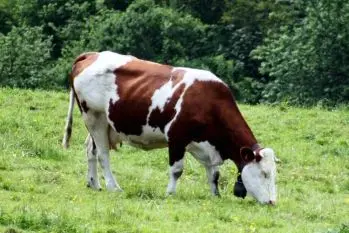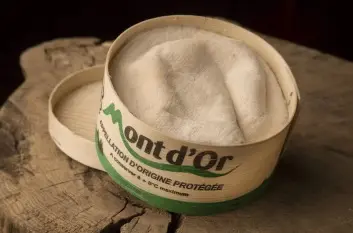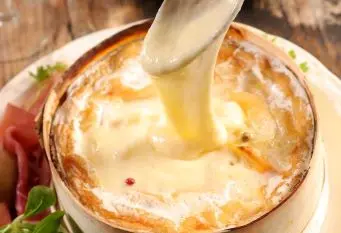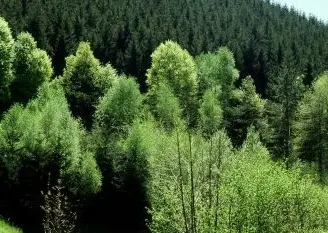The blog of cooking-ez.com
In praise of Mont d'Or cheese

Do you know the Mont d'Or, this extraordinary cheese from the Haut-Doubs in France, with a unique taste and appearance, which can be eaten both raw and cooked?
I'll tell you a few words about it, and with some tips on how to choose it and cook it.
I'll tell you a few words about it, and with some tips on how to choose it and cook it.
7,025 14 5
Last modified on: November 27th 2021
Keywords for this post:CheeseFranche-comtéJuraDoubsCreamyVacherinIn praise of Mont d'Or cheese
What is Mont d'Or?
The Mont d'Or is a cheese that comes exclusively from a small area of appellation that is located in the upper part of the Doubs department, in Franche-Comté, in the Jura mountains.It is a cow's cheese, whose milk, raw only, is strictly controlled: Montbéliarde or "pie rouge de l'est" breed exclusively, grass/hay feed only, no silage, and a production area delimited in surface and in altitude, 700 meters minimum.

It is also a seasonal cheese, it is only produced from 15 August to 15 March and only sold from 10 September to 10 May approximately, these dates are under the jurisdiction of the Prefect of the Doubs who publishes a decree each year authorising both.
Yes, it is a regulated cheese...
Add to all its specificities a unique packaging, the cheese is put in a spruce box, in which it is surrounded by a strap of inner bark of spruce, the liber.
This strap is collected by people called "sangliers" or "sanglières", just after the felling of the spruce trees and before their skidding, it contributes to the taste of the cheese, woody of course.

Once the scene is set, what do we have?
A rather exceptional cheese, AOC in 1981 and AOP in 1996, known since the Middle Ages, creamy, tasty and made only with good raw milk from local cows, which only graze, and always have horns and bells, the "clarines".
How to choose it?
Since it is strictly regulated and protected, you have very little risk of being cheated, just check on the box where it comes from, make sure it has a postcode starting with 25 or 39.You can easily find it in supermarkets, or better still at your local cheese shop.
At the beginning of its maturity the Mont d'Or is quite flat, then as it matures the top of the cheese becomes more undulating, creating "waves" that the people of France call "fesses" (buttocks), "A good Mont d'Or must have beautiful fesses" they like to say...
So if you have an irregular top of cheese (like on the picture below) it's a good sign, it is mature.

Keep it in the fridge if it is already well advanced, at room temperature or in the fridge if it is a bit young.
Tasting
If you eat it cold, like a classic cheese, it must be at room temperature and well done, it is then very creamy, almost runny.Traditionally, it is tapped vertically with a (small) spoon to serve it to yourself, no chunks are cut off like for a Camembert for example.
As with all cheeses, choose a bread of your own taste, a gogod one made by your baker, if possible with sourdough, but this is a very personal taste.

If you eat it hot, it is the famous "hot box", in this case put your oven at 360°F (180°C) and put your potatoes in.
After 15 minutes, add the Mont d'Or in its box, until it is melted and the top crust is well toasted, usually the potatoes are cooked at the same time.

Traditionally, before putting the cheese in the oven, make a small hole in the middle with a spoon, and fill the cavity with dry white wine, from the Jura if possible.
Discreetly devour the piece of cheese removed on a small piece of bread, while serving yourself a glass of the same wine, guaranteed pleasure, certainly a little selfish, but it is the privilege of the one who puts the cheese in the oven.
Note that 360°F (180°C) is the right temperature, beyond that the cheese in a too hot oven can slice and dissociate.
Place the potato dish, the Mont d'Or and any delicatessen in the middle of the table, then each person helps himself or herself by peeling and cutting the potatoes and sprinkling them with melted cheese.
Always serve the same wine to your guests, and enjoy this fabulous moment of sharing...
I'll end by telling you that our Swiss neighbours make a very similar cheese which they call "Vacherin mont d'or", but which can be made from thermised milk, not just raw milk.
On the other hand, their AOP requires them to have locally produced straps, so Swiss or French, while some big French cheese factories buy cheap straps from Eastern Europe, for a question of cost of course.
What a pity this sad commercial logic, with all the spruce forests around.

In summary: Mont d'or is an extraordinary creamy and tasty cheese, which can be eaten both raw and cooked.
PS: If you taste Mont d'Or with a "traditional French" baguette (the best ones), not only is it delicious, but you will also be tasting the only bread-cheese association in the world that is regulated, as both this cheese and this bread are subject to regulations (decree and order). In France, food is a very serious matter...
Lasts posts
Wipe meats and fish before cooking
When you want to cook meat or fish, there's a very simple yet very important step to take before you even start: It's to dry, or wipe, each side of the meat or fish, sometimes called "dabbing" or "sponging". But why? And how? Let me explain.8005 April 14th 2024
Toss the salad
When you've finished preparing a salad, green or otherwise, it's usually time to add the dressing and toss. It's often said to "toss the salad", which means to season and mix. Is it easy? Not so easy...2,4055 March 8th 2024
Half milk, half cream
In a multitude of recipes, savoury or sweet, milk is used as the main ingredient, or at least as the main liquid ingredient. Milk is used instead of water, for example, because milk contains a proportion of fat, which adds roundness and softness to the recipe. This mellowness is very pleasant on...2,334 February 27th 2024
Cutting soft cheeses
As you may have already noticed, when you have to use a "soft" cheese in a recipe - their exact name is "soft cheese" - such as Camembert, Munster or Mont d'or, it's not easy to make anything other than thick slices.2,4755 February 20th 2024
It's spinning too fast!
When you need to grate or slice vegetables, you generally use an electric machine that does all the work: a food processor, a mixer with a "slicer" extension or similar. Are these machines really suitable? Generally speaking, yes of course, but there's one criterion that often poses a problem,...5,3795 November 12th 2023
Other pages you may also like
Wipe meats and fish before cooking
When you want to cook meat or fish, there's a very simple yet very important step to take before you even start: It's to dry, or wipe, each side of the meat or fish, sometimes called "dabbing" or "sponging". But why? And how? Let me explain.8005 April 14th 2024
In praise of slow cooking
You will no doubt have noticed that in cookery, it's often the actual cooking process that gets neglected. This is understandable; it comes at the end of the recipe and getting the dish in the oven is something of a relief (ah, that's done!), which frees us to cope with what's left: tidying the...36K4.2 February 9th 2011
Butter doesn't make you fat, unless you eat too much of it.
Whenever I'm discussing cooking and recipes, there is one idea which comes up frequently, like this: "Oh no! But that's got butter in it" (I should add, for the sake of accuracy, that this is something I hear more frequently from women, who are almost all concerned with keeping their figure). ...38K4.5 March 26th 2012
Different kinds of pastry and dough
When cooking in general, and particularly in baking, we can make and use many different kinds of pastry and dough. All built on the same "base": flour - a powder to which we add fat, liquid or both to produce the dough which is then cooked. .104K 14.0 November 6th 2012
How to zest a fruit?
You will have no doubt noticed that many recipes call for the zest of citrus fruit. The zest is that outer layer of the skin which adds so much flavour to a dish. There are many different ways to peel off the zest and various tools are available. Here is a summary of the “dos and don'ts” of...40K3.8 November 5th 2013
Post your comment or question
Follow this page
If you are interested in this page, you can "follow" it, by entering your email address here. You will then receive a notification immediately each time the page is modified or a new comment is added. Please note that you will need to confirm this following.
Note: We'll never share your e-mail address with anyone else.
Alternatively: you can subscribe to the mailing list of cooling-ez.com , you will receive a e-mail for each new recipe published on the site.








